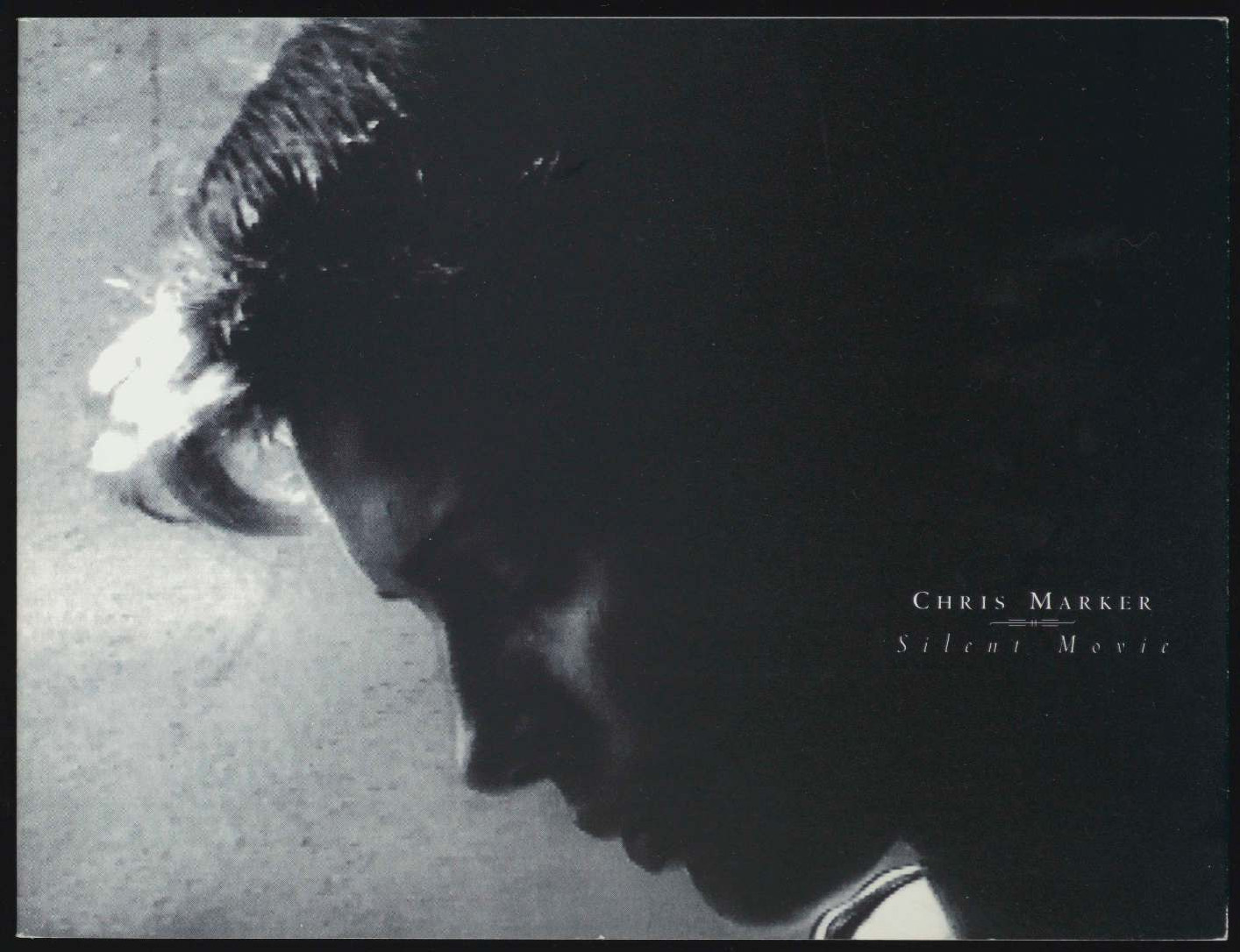Chris Marker: Silent Movie (1995)
Filed under artist publishing, catalogue | Tags: · cinema, film, film history, silent cinema, silent film

In Silent Movie, “Marker employs five-channels of video, each a thematic exploration of early cinema. Film images disclosing ‘The Journey,’ ‘The Face,’ ‘The Gesture,’ and ‘The Waltz’ occupy four of the monitors while on the fifth (and middle) monitor is a collection of ninety-four silent-era intertitles, ‘telling short, mysterious pieces of unknown stories.’ These moving images travel through a computer interface that assembles an ever-changing array of sequences. At any given moment, each passage is in unique juxtaposition with the other images passing across the surrounding monitors. Coloration, tone, and association are governed by chance contiguities; even the intertitles narrate across a field of fluid relationships.” (Source)
“Silent Movie. To give an installation the name of something that never existed is probably less innocent than the average cat may infer. There was never anything like silent cinema, except at the very beginning, or in film libraries, or when the pianist had caught a bad flu. There was at least a pianist, and soon an orchestra, next the Wurlitzer, and what contraptions did they use, in the day of my childhood, to play regularly the same tunes to accompany the same film? I’m probably one of the last earthlings–the ‘last,’ says the cat–to remember what themes came with what films: ‘A Midsummer Night’s Dream’ on Wings (the dogfights), Liszt’s ‘The Preludes’ on Ben Hur. A touch of humour noir here, to think that the saga of the young hebrew prince was adorned by Hitler’s favorite music, which in turn explains why you hear it more often than Wagner on the German war newsreels–but I get carried away. …”–Chris Marker (book page 15)
Edited by Ann Bremner
Publisher Wexner Center for the Arts, Ohio State University, Columbus/OH, 1995
ISBN 1881390101
40 pages
via MoMA
PDF
Video excerpt (8 min)
Radical Light: Alternative Film and Video in the San Francisco Bay Area, 1945-2000 (2010)
Filed under book, catalogue | Tags: · art history, california, experimental film, film, film history, san francisco, video, video art

“This kaleidoscopic collection of essays, interviews, photographs, and artist-designed pages chronicles the vibrant and influential history of experimental cinema in the San Francisco Bay Area. Encompassing historical, cultural, and aesthetic realms, Radical Light features critical analyses of films and videos, reminiscences from artists, and interviews with pioneering filmmakers, curators, and archivists. It explores artistic movements, film and video exhibition and distribution, artists’ groups, and Bay Area film schools. Special sections of ephemera—posters, correspondence, photographs, newsletters, program notes, and more—punctuate the pages of Radical Light, giving a first-hand visual sense of the period. This groundbreaking, hybrid assemblage reveals a complex picture of how and why the San Francisco Bay Region, a laboratory for artistic and technical innovation for more than half a century, has become a global center of vanguard film, video, and new media.
Among the contributors are Rebecca Solnit and Ernie Gehr on Bay Area cinema’s roots in the work of Eadweard Muybridge and others; Scott MacDonald on Art in Cinema; P. Adams Sitney on films by James Broughton and Sidney Peterson; Stan Brakhage, Bruce Conner, Lawrence Jordan, and Yvonne Rainer on the Bay Area film scene in the 1950s; J. Hobeman on films by Christopher Maclaine, Bruce Conner, and Robert Nelson; Craig Baldwin on found footage film; George Kuchar on student-produced melodramas; Michael Wallin on queer film in the 1970s; V. Vale on punk cinema; Dale Hoyt and Cecilia Dougherty on video in the 1980s and 1990s; and Maggie Morse on new media as sculpture.”
Edited by Steve Anker, Kathy Geritz and Steve Seid
Publisher University of California Press, and Berkeley Art Museum and Pacific Film Archive, Berkeley, 2010
ISBN 9780520249103, 0520249100
352 pages
Reviews: Molly H.Cox (Other Cinema, 2011), Lucy Raven (BOMB, 2011), Federico Windhausen (Moving Image, 2012), Mike Leggett (Leonardo, 2012).
Exhibition
Publisher (BAMPFA)
Publisher (UC Press)
WorldCat
multiple formats (on Internet Archive)
PDF (35 MB)
Aleksandr Deineka (1899-1969): An Avant-Garde for the Proletariat (2011) [EN, ES]
Filed under catalogue | Tags: · art, avant-garde, painting, revolution, russia, socialist realism, soviet union

“This is the first exhibition and publication to present this outstanding figure of socialist realism – and, by extension, the historical period from which his work was borne – in a twofold context: the end of the avant-garde and the advent of Soviet socialist realism. It covers Deineka’s entire oeuvre, from his early paintings of the 1920s to the twilight of his career in the 1950s, when the dreamlike quality of his first works gave way to the harsh materiality of everyday life, the life in which the utopian ideals of socialism seemed to materialize. Combining Deineka’s graphic work, posters and contributions to illustrated magazines and books with his monumental paintings, this catalogue displays a variety of subjects: factories and enthusiastic masses, athletes and farmers, the ideal and idyllic image of Soviet life.”
With essays by Manuel Fontán del Junco, Christina Kiaer, Ekaterina Degot, Boris Groys, Fredric Jameson, Irina Leytes, and Alessandro De Magistris. Includes an extensive section with documents of the Russian avant-garde, Revolutionary Art and Socialist Realism (1913-35) and texts by and about Deineka (1918-64).
Publisher Fundación Juan March, Madrid, 2011
ISBN 9788470755927, 8470755927
440 pages
Exhibition
Publisher
WorldCat (EN)
Deineka: An Avant-Garde for the Proletariat (English, 30 MB)
Deineka: Una vanguardia para el proletariado (Spanish, 30 MB)

